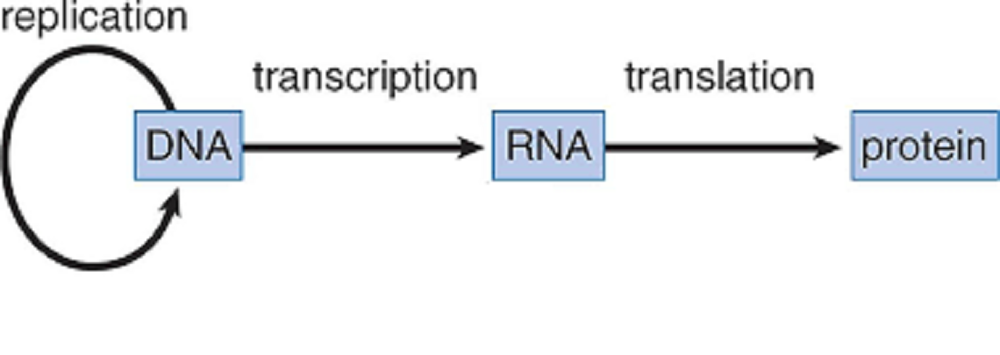Challenge 3: Molecular Hijacking - How does a virus take over?
Learning Targets:
- I can discuss the role of the Central Dogma in viral replication.
- I can describe the specifics of how the SARS-CoV-2 virus takes over a host cell in order to replicate and make many copies of itself.
Watch:
Covid-19: An Illustrated Scientific Summary
Read:
Read & Decide:
"Bring, Build, Borrow, or Steal"
To complete this activity, you will read the information provided and then use the following verbs: bring, build, borrow or steal to fill in the words missing from the paragraph below. You must choose one of those four words. First, read the important information below.
Background : Viruses are clever entities and they are minimalists. Most viruses carry very little within their capsid (and envelope if they have one) and the majority of their insides is genetic material made of either strand(s) of deoxyribonucleic acid (DNA) or ribonucleic acid (RNA). The viral genome (genetic material) has the instructions, aka genes, to take over the host cell and to build new copies of itself. This process of host cell takeover is known as “molecular hijacking.” When a virus replicates it has to build entire viral particles and it has to not only make the proteins that comprise the viral capsid (and enclose it with an envelope), but it must also replicate its genetic material.

The Central Dogma is a concept coined by Francis Crick in the 1950s. Crick received a Nobel Prize along with his colleague James Watson for elucidating the structure of DNA. The Central Dogma (pictured below) describes the transfer of genetic information (blueprints) into function in a cell. DNA, which is the makeup of the genome of most organisms, can be replicated, but also transcribed into RNA molecules, which are then translated into proteins. Proteins go on to perform functions, such as the capsid of a virus is made of proteins that provide a structure to encapsulate the viral genome.
Facts: Host cells and viruses have many, many differences with respect to the proteins and molecules within each. Because the virus is a minimalist and carries only a few things with it, it has to either borrow or steal the machinery of the host cell it infects or it must bring the blueprints to build what it needs.
The host cell has the following:
- DNA polymerase – the enzyme needed to replicate DNA (DNA --> DNA) ·
- RNA polymerase - the enzyme required to transcribe DNA into RNA (DNA --> RNA) ·
- Ribosomes – the entities responsible for translating RNA into proteins (RNA --> Proteins) ·
- Phospholipids that make up membranes
Fill in the blanks:
Now decide which word (bring, build, borrow, or steal) correctly fills in the blanks in the paragraph below. Remember that borrowing is distinct from stealing; assume borrowing involves the return of the goods to the host, but stealing does not. SARS-CoV-2, the virus that causes COVID-19, has a protein capsid that is surrounded by a phospholipid envelope. Inside its capsid is a genome of RNA. Spike proteins called, S proteins, recognize the ACE2 receptors of host cells allowing the virus to enter the host cell. Upon entry into the host cell, the virus hijacks the host and turns it into a factory producing many, many copies of SARS-CoV-2. First, the virus ____________ its own genome of RNA, which then needs to be coded into proteins. Thus, the virus ____________ the genes coding for viral structure, such as capsid and spike proteins. Then the virus must code these genes into proteins and ___________ ribosomes for translation, a process that also requires the virus to __________ amino acids, which are the building blocks of proteins. In doing this, the virus __________ many capsid and spike proteins to make many viral particles. SARS-CoV-2 also ____________ a gene that codes for a protein enzyme that is capable of copying RNA into more RNA molecules. This way the virus can then ____________ many, many copies of its own genetic material to be carried within each viral particle produced. This protein enzyme, called an RNA-dependent RNA polymerase, will then copy the virus’s RNA genome which requires it to ___________ ribonucleotides, which are the building blocks of RNA molecules. Once the capsid, spike proteins, and RNA genomes are produced, they are assembled and get ready to leave the host cell. Upon exit, each virus obtains its envelope and when doing so, the virus particles ___________ phospholipids from the host cell’s membrane. One the new viral particles exit the cell, they go on to find new cells to infect.
Model:
SARS-CoV-2 is an RNA virus, meaning its RNA genome can be directly translated into proteins, but it needs to make copies of its RNA genome when the virus replicates, a process that cannot naturally occur in animal cells. If a virus has a genome composed of DNA, such as the viruses that cause herpes, HPV, and chicken pox to name a few, then the virus needs a very different strategy to hijack its host cell. Think about what enzymes these viruses can borrow from the host cell in order to replicate entirely. Draw and model a viable strategy a DNA virus uses to hijack its host cell.
Reflect:
The human immunodeficiency virus (HIV), which is the virus that causes AIDS, also has an RNA genome, but this virus does not use the same strategy for molecular hijacking as SARS-CoV-2. HIV can remain latent in host cells, meaning it is not actively replicating and making many copies, but rather it hides out and replicates only once along with the host cell when it divides. In order to do this, HIV integrates its genome into that of the host cell. Considering this, what must HIV bring into the host cell and what process must occur in order to integrate the viral genome into the host cell’s genome?